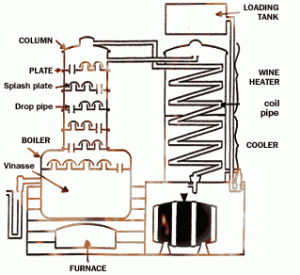The Difference Between Armagnac and Cognac Production
The difference between armagnac and cognac production is considerable. Originally the predominance of Ugni Blanc and to a very much lesser degree, the Folle Blanche and Colombard grapes in the vineyards of Cognac provided a basis for Armagnac production. Now the use of Folle Blanche is considerably greater and another grape variety is also allowed. Known as Baco, it is a cross between the Folle Blanche and the Noah, a grape not known for making quality wine but in many ways ideal for armagnac since it crops relatively late and in good quantities.
As with cognac the winemaking is relatively basic using natural yeasts to eschew sulphur dioxide, sugar and other additives. The process is designed to produce an acceptably neutral raw material for distillation. There is, however, one crucial difference. The Armagnaçais are allowed to use the continuous presses (forbidden for use in Cognac) which often include the pips, skins and other impurities that further increase the potential richness of the spirit.
This richness is also intensified by the use of a special type of continuous still. Developed during the nineteenth century it is now known as the traditional armagnac still. The ‘jet continu’ (flowing continuously) method of distillation has been responsible for the region’s fame and fortune since the end of the nineteenth century. The wine, ‘chauffe-vin’, is heated in a cylinder by the pipes containing hot alcoholic vapours from the still. The wine, now heated to 80 degrees, then runs into the upper half of a double still (see diagram). In the old days this would enter from the top but on more modern stills it enters below the top plate.
The clash allows the vapour to absorb some of the qualities and congeners of the incoming wine. The lower the plates the hotter they are thereby ridding the descending wine of an increasing proportion of its alcohol content. As it reaches the lower still the wine is boiling at just over 100 degrees Celcius. The solid residue of the distillation, known as ‘vinasses’, is evacuated through a pipe in the lower half of the still; the ‘têtes’ can then be taken off from the head of the ‘chauffe-vin’. The armagnac method of distillation is potentially richer in congeners and fruity and ester-ish flavours, than the stronger spirits made in orthodox pot stills. Even today the armagnac spirit can emerge from the still as low as 52 degrees, a good 15 degrees lower than cognac. This partly explains armagnac’s fruity and slightly coarser qualities.
Armagnac, once distilled, requires careful handling. Made in the traditional way the spirit retains more of the original wine. This is partly due to the impurities which render the spirit unappetizingly raw for a longer time than spirits distilled by other methods. It is these impurities that make armagnac interesting and provide a wealth of different flavours and qualities often dominated by prune flavours.
Read more about Armagnac in Technical Topics on our Brandy Education page.

